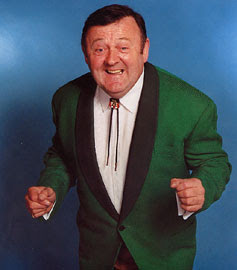Ina Anita Carter (March 31, 1933 – July 29, 1999) was an American singer who played upright bass, guitar, and autoharp. She performed with her sisters, Helen and June, and her mother, Maybelle, initially under the name The Carter Sisters and Mother Maybelle. Carter had three top ten hits as well as other charting singles. She was the first to record the songs "Blue Boy" and "Ring of Fire". Carter was also a songwriter, most notably co-writing the Johnny Cash hit "Rosanna's Going Wild." The epithet most widely used to characterise her soprano voice was "achingly pure".
 |
| L-R June, Maybelle, Anita & Helen |
A member of country music's most famous family, Anita Carter found success of her own as a folk solo act during the early '50s and late '60s. The Carter Family had ruled country music during the 1930s, but broke up in 1943 after patriarch A.P. Carter and his ex-wife Sara decided to retire. Sara's cousin Maybelle, the third member of the Carters, re-formed the group the same year as Mother Maybelle & the Carter Sisters with her daughters Helen, June, and Anita. The sisters had sung on Carter Family radio broadcasts in 1935, and the new group more than made up for the breakup of the originals. The Carters performed on radio from Virginia, Tennessee, and Missouri during the late '40s, but moved to the Grand Ole Opry in 1950.
In 1951, Anita stormed the charts with a one-off duet with Hank Snow; both "Bluebird Island" and its B-side, "Down the Trail of Achin' Hearts," reached the country Top Five. On March 26, 1952, she appeared on The Kate Smith Evening Hour with her family band "The Carter Sisters and Mother Maybelle" as the first females to represent hillbilly/country music and Music City Nashville on national television. On April 23, she returned to the program, where she performed a duet with Hank Williams, on his song "I Can't Help It (If I'm Still in Love with You)". |
| Nita, Rita & Ruby |
Then on May 21, she became the first female star of the Grand Ole Opry to sing a solo on The Kate Smith Evening Hour when she sang "Just When I Needed You". It was during the mid-'50s that she also performed with the teen trio 'Nita, Rita & Ruby, but spent most of her time with the Carters. The group continued to be popular on the Opry, and even opened for Elvis Presley in 1956-1957. After A.P. Carter's death in 1960, Mother Maybelle and the Carter Sisters became the Carter Family and performed more contemporary country than gospel.
In 1961, the Carters began a long-running association with Johnny Cash by appearing in his road show. In 1962, she recorded "Love's Ring of Fire," written by her sister June and Merle Kilgore. After the song failed to make the charts, Johnny Cash recorded it as "Ring of Fire" in March 1963 with the horns and the Carter Sisters (along with Mother Maybelle). This version became a hit for Cash. The Carters also recorded the country Top 15 single "Busted" with Cash that year, and after June Carter married him in 1967, the Carters appeared on his ABC-TV show from 1969 to 1971. Though the Carter Family continued to record usually with Cash during the early '70s, they disbanded in 1969. Mother Maybelle became recognized as a major figure in the folk revival that year, appearing with Sara at the Newport Folk Festival and on the Rounder album An Historic Reunion.
Meanwhile, Anita had begun to record for RCA in 1966, hitting the country charts with "I'm Gonna Leave You." Another single charted in 1967, and her duet with Waylon Jennings on "I Got You" reached number four in March 1968. Later in 1968, Anita moved to United Artists, but several singles proved unsuccessful. She recorded for Capitol in the early '70s and almost hit the Top 40 with "Tulsa County." Her last chart appearance with the Carter Family, "Praise the Lord and Pass the Soup," was released in August 1973.
 |
| L-R Helen, June, Anita & Carlene |
After Maybelle's death in 1978, Helen and Anita continued as part of the Cash troupe, which sometimes included a third generation of the Carter family, among them Anita's daughter, Lori. The three sisters and June's daughter, Carlene, gave a memorable show at the 1986 Wembley Festival of Country Music. The Carter sisters and their daughters made albums together in 1982 and 1988. Anita, Helen and June also made a guest appearance on the second volume of the Nitty Gritty Dirt Band's album, Will The Circle Be Unbroken, in 1990.
For the remainder of the decade Anita's activities were curtailed by severe arthritis and the drugs used to treat it severely damaged her pancreas, kidneys, and liver. She died in Tennessee on July 29, 1999, at the age of 66, a year after eldest sister Helen and four years before middle sister June. She was under hospice care at the home of Johnny and June Carter Cash in Hendersonville, Tennessee. Her interment was in Hendersonville Memory Gardens in Hendersonville, Tennessee.
Carter married fiddler Dale Potter in 1950 (marriage was annulled shortly thereafter), session musician Don Davis in 1953 (divorced and then remarried), and Bob Wootton (lead guitarist for Johnny Cash's band The Tennessee Three) in 1974 (divorced). She had two children.
(Edited from Wikipedia, The Guardian & AllMusic)















































.tif.jpg)
